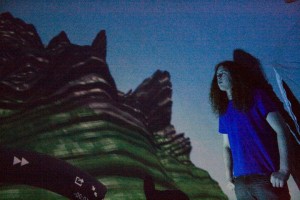Displayed at Pixelache 2011 in Helsinki.
Monthly Archives: January 2011
IDAT211 – The .OBJ file
In-order to create code output the terrain I had to pick and understand a 3D model file format.
I explored a number of formats by exporting a flat square from blender and loaded the resulting file into a text editor from this I found the simplest format for me to use which was Wavefront OBJ. The advantages were that it was relatively simple to adapt my terrain code to to output, it was relatively light preventing the model file becoming too large.
mtllib mat.mtl
usemtl sand
v 1 0.0 1
v 1 0.0 2
v 2 0.0 2
v 2 0.0 1
f 1 2 3 4
usemtl sand
v 1 0.0 2
v 1 0.0 3
v 2 0.0 3
v 2 0.0 2
f 5 6 7 8
usemtl sand
v 1 0.0 3
v 1 0.0 4
v 2 0.0 4
v 2 0.0 3
f 9 10 11 12
...
mtllib – ource of the materials
usemtl – material for the face
v – location of a point
f – points to join to make a face
The output portion of my code that writes the .obj file:
for (int x = 1; x < musicArray.length-1; x++) {
for (int y = 1; y < rows-1; y++) {
data[len] = "usemtl sand";
if(Zarray[x][y] > 3)data[len] = "usemtl grass";
if(Zarray[x][y] > 35)data[len] = "usemtl mountain";
if(Zarray[x][y] > 60)data[len] = "usemtl snow";
data[len+1] = "v " + x + " " + Zarray[x][y] + " " + y;
data[len+2] = "v " + x + " " + Zarray[x][y+1] + " " + (y+1);
data[len+3] = "v " + (x+1) + " " + Zarray[x+1][y+1] + " " + (y+1);
data[len+4] = "v " + (x+1) + " " + Zarray[x+1][y] + " " + y;
data[len+5] = "f " +face+ " " +(face+1)+ " " +(face+2)+ " " +(face+3);
face+=4;
len+=6;
}
println((x/(musicArray.length/100)) + "%");
}
IDAT211 – Materials
As I was using the .OBJ format I needed to use a .MTL file for the materials. When an .OBJ file is imported into blender it also imports MTL files referenced within it.
I decided not to use textures for a number of reasons, the main one was that I wasn’t attempting to make it realistic but still recognizable.
The .MTL file I used in the final version was:
newmtl sand
Kd 1.000 1.000 0.600
illum 0
newmtl grass
Kd 0.300 0.700 0.400
illum 0
newmtl mountain
Kd 0.700 0.700 0.700
illum 0
newmtl snow
Kd 1.000 1.000 1.000
illum 0
newmtl water
Kd 0.400 0.400 1.000
illum 0
IDAT211 – The Process
IDAT211 – Rendering
The render time was approximatly 10 hours for the 3000 frames at 1400 x 1050, saving each as JPEGs.
Render 1
My original plan was to directly convert the sound data to the path of the camera. The effect of this was that the camera looked up and down very quickly and at points clipped through the mountain.
Render 2
I then tried smoothing this out in illustrator, the effect of this was slightly reduced but accidentally introduced a backflip.
Render 3
Decided to use the previous SVG and draw out a smooth path. 2500 frames into the render I found that the path had been accidentally deformed sending the camera off the terrain model.
Render 4
Perfect
After this I imported the frames into After Effects and added the credits and syncronised the music with it.

